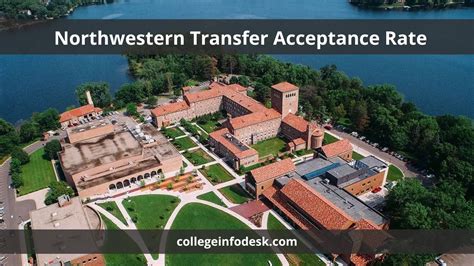Are you an aspiring student seeking admission to the prestigious Northwestern University as a transfer student? Understanding the university’s transfer rate is crucial for planning your application strategy and maximizing your chances of success. This article provides a comprehensive overview of Northwestern’s transfer rate, explores the factors influencing it, and offers valuable guidance on the transfer application process.

Demystifying Northwestern’s Transfer Rate
Northwestern University maintains a highly competitive transfer admission process. Historically, the university’s transfer acceptance rate has ranged between 6% and 10%, signifying the rigorous selection process. The university receives thousands of transfer applications each year, but only a small percentage of applicants are granted admission.
Factors Influencing the Transfer Rate
Several factors contribute to Northwestern’s selective transfer admission process:
- Academic Performance: Northwestern places significant emphasis on academic excellence. Transfer applicants must maintain strong GPAs in their coursework, particularly in core subjects such as math, science, and English.
- Rigor of Curriculum: The university favors applicants who have taken rigorous coursework at their previous institution. This includes challenging honors, AP, or IB classes.
- Standardized Test Scores: While not required for transfer applications, standardized test scores (SAT or ACT) can enhance an applicant’s profile. High scores demonstrate academic readiness and strengthen the application.
- Extracurricular Involvement: Northwestern values well-rounded individuals. Transfer applicants should actively participate in extracurricular activities that demonstrate their leadership, involvement, and commitment to their community.
- Personal Statement and Letters of Recommendation: The personal statement and letters of recommendation provide an opportunity for applicants to showcase their individuality, aspirations, and qualifications. These components should be crafted thoughtfully and highlight the applicant’s unique strengths.
Common Mistakes to Avoid in the Transfer Application Process
To ensure the best possible chance of success, transfer applicants should avoid common mistakes:
- Not researching the university: Familiarity with Northwestern’s academic programs, campus culture, and transfer requirements is essential.
- Applying to too many universities: Casting a wide net may reduce the time and effort allocated to each individual application.
- Neglecting extracurricular activities: Extracurricular involvement strengthens the application and demonstrates the applicant’s commitment beyond academics.
- Overestimating chances of admission: Recognizing the competitiveness of Northwestern’s transfer process is crucial. Applicants should set realistic expectations.
- Procrastinating on deadlines: Submitting the application and required materials on time is paramount.
A Step-by-Step Guide to the Northwestern Transfer Application Process
- Plan: Determine your academic and career goals, research Northwestern, and gather necessary application materials.
- Submit Application: Create a Common App account and submit the application before the deadline.
- Request Transcripts: Submit official transcripts from all previously attended institutions.
- Obtain Letters of Recommendation: Secure letters of recommendation from professors, advisors, or supervisors who can attest to your academic abilities and personal qualities.
- Optional: Submit Standardized Test Scores: While not required, standardized test scores can enhance the application.
- Prepare Personal Statement: Craft a compelling personal statement that showcases your passions, aspirations, and why Northwestern is the right fit for you.
- Review Application: Thoroughly review your application before submitting it.
- Monitor Status: Track the status of your application through the Common App portal.
- Decision: Northwestern will notify transfer applicants of their admission decision by March 31st.
Additional Strategies for Enhancing Northwestern Transfer Chances
- Build a Strong Academic Profile: Maintaining a high GPA and taking a rigorous curriculum demonstrate academic readiness.
- Seek Mentorship: Connect with professors, advisors, or transfer counselors who can provide guidance and support throughout the application process.
- Attend Virtual Events: Participate in virtual events hosted by Northwestern to learn more about the university and the transfer process.
- Consider a Gap Year: Applying during a gap year may provide an opportunity to enhance your application through additional coursework, work experience, or personal growth.
- Be Yourself: Showcase your unique strengths, interests, and aspirations in your application.
Conclusion
Northwestern University’s transfer admission process is highly competitive, but with careful planning, a strong application, and a positive attitude, aspiring transfer students can increase their chances of success. By understanding the transfer rate, its influencing factors, and following the guidance provided in this article, applicants can navigate the application process effectively and pursue their academic ambitions at this esteemed institution.
Tables
Table 1: Northwestern Transfer Statistics
| Year | Number of Applicants | Number Admitted | Acceptance Rate |
|---|---|---|---|
| 2021-2022 | 15,231 | 1,583 | 10.4% |
| 2020-2021 | 14,962 | 1,487 | 9.9% |
| 2019-2020 | 14,593 | 1,425 | 9.8% |
Table 2: Common Mistakes in Northwestern Transfer Applications
| Mistake | Impact |
|---|---|
| Not researching Northwestern | Poor fit with university |
| Applying to too many universities | Insufficient time and effort for Northwestern application |
| Neglecting extracurricular activities | Weak demonstration of commitment and well-roundedness |
| Overestimating chances of admission | Disappointment and missed opportunities |
| Procrastinating on deadlines | Application not submitted on time |
Table 3: Strategies for Enhancing Northwestern Transfer Chances
| Strategy | Benefit |
|---|---|
| Build a Strong Academic Profile | Demonstrates readiness and academic excellence |
| Seek Mentorship | Guidance and support throughout the application process |
| Attend Virtual Events | Learn about Northwestern and the transfer process |
| Consider a Gap Year | Enhance application through additional experiences |
| Be Yourself | Showcase your unique strengths and aspirations |
Table 4: Important Transfer Deadlines
| Deadline | Action |
|---|---|
| October 15th | Early Decision I Application |
| November 1st | Early Decision II Application |
| January 1st | Regular Decision Application |
